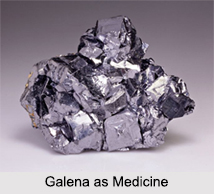 Galena or sulphide of lead is called Anjana or Sauviranjana in Sanskrit. It is called Anjana, which literally means collyrium or medicine for the eyes, from the circumstance of its being considered the best application or cosmetic for them. The other varieties of Anjana mentioned are Srotonjana, Pushpanjana and Rasanjana.
Galena or sulphide of lead is called Anjana or Sauviranjana in Sanskrit. It is called Anjana, which literally means collyrium or medicine for the eyes, from the circumstance of its being considered the best application or cosmetic for them. The other varieties of Anjana mentioned are Srotonjana, Pushpanjana and Rasanjana.
Sauviranjana is said to be obtained from the mountains of Sauvira, a country along the Indus, hence it derives its name. Srotonjana is described as of white colour, and is said to be produced in the bed of the Yamuna and other rivers. Pushpanjana is described as an alkaline substance. Rasanjana is the extract of the wood of Berberis Asiatica called Rasot in the vernacular.
Benefits of Galena
Galena is chiefly used as a cosmetic for the eyes, and is supposed to strengthen these organs, improve their appearance and preserve them from disease.
Dose of Galena in Medicine
Galena enters into the composition of some collyria for eye diseases. Galena, heated over a fire and cooled in a decoction of the three myrobalans for 7 times in succession, is rubbed with human milk and used in various eye diseases.
Another collyrium prepared with lead is as follows; to 1 part of purified and melted lead, add an equal portion of mercury and 2 parts of galena. Rub them all together and reduce to powder. Now add camphor, equal in weight to one-tenth part of the mass and mix intimately. This preparation is said to be useful in eye diseases.
This article is a stub. You can enrich by adding more information to it. Send your Write Up to content@indianetzone.com




















